Johannes Oetsch
Jonkoping University, Sweden
ASP-FZN: A Translation-based Constraint Answer Set Solver
Jul 30, 2025Abstract:We present the solver asp-fzn for Constraint Answer Set Programming (CASP), which extends ASP with linear constraints. Our approach is based on translating CASP programs into the solver-independent FlatZinc language that supports several Constraint Programming and Integer Programming backend solvers. Our solver supports a rich language of linear constraints, including some common global constraints. As for evaluation, we show that asp-fzn is competitive with state-of-the-art ASP solvers on benchmarks taken from past ASP competitions. Furthermore, we evaluate it on several CASP problems from the literature and compare its performance with clingcon, which is a prominent CASP solver that supports most of the asp-fzn language. The performance of asp-fzn is very promising as it is already competitive on plain ASP and even outperforms clingcon on some CASP benchmarks.
Visual Graph Question Answering with ASP and LLMs for Language Parsing
Feb 13, 2025
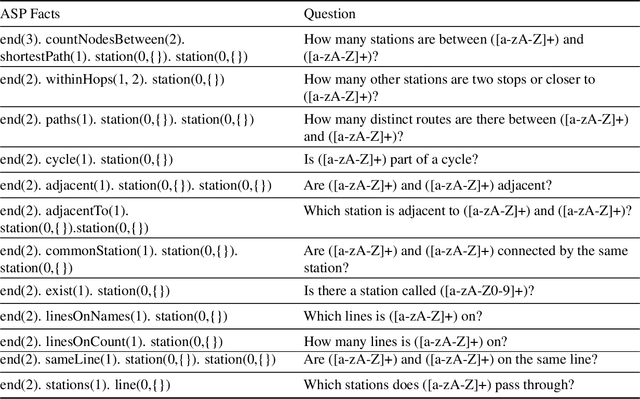


Abstract:Visual Question Answering (VQA) is a challenging problem that requires to process multimodal input. Answer-Set Programming (ASP) has shown great potential in this regard to add interpretability and explainability to modular VQA architectures. In this work, we address the problem of how to integrate ASP with modules for vision and natural language processing to solve a new and demanding VQA variant that is concerned with images of graphs (not graphs in symbolic form). Images containing graph-based structures are an ubiquitous and popular form of visualisation. Here, we deal with the particular problem of graphs inspired by transit networks, and we introduce a novel dataset that amends an existing one by adding images of graphs that resemble metro lines. Our modular neuro-symbolic approach combines optical graph recognition for graph parsing, a pretrained optical character recognition neural network for parsing labels, Large Language Models (LLMs) for language processing, and ASP for reasoning. This method serves as a first baseline and achieves an overall average accuracy of 73% on the dataset. Our evaluation provides further evidence of the potential of modular neuro-symbolic systems, in particular with pretrained models that do not involve any further training and logic programming for reasoning, to solve complex VQA tasks.
* In Proceedings ICLP 2024, arXiv:2502.08453. This work was partially funded from the Bosch Center for AI
Declarative Knowledge Distillation from Large Language Models for Visual Question Answering Datasets
Oct 12, 2024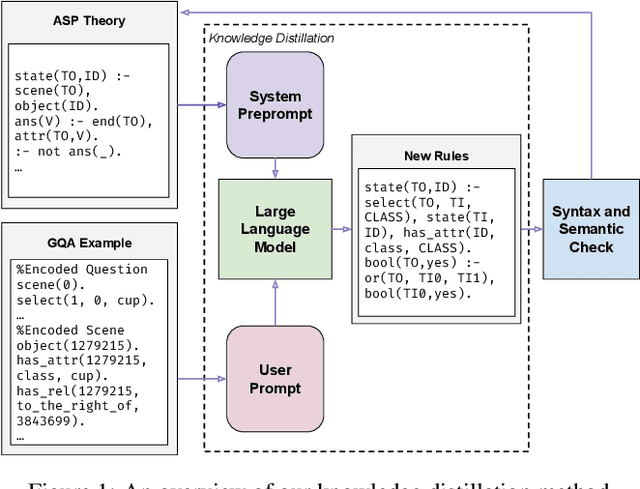
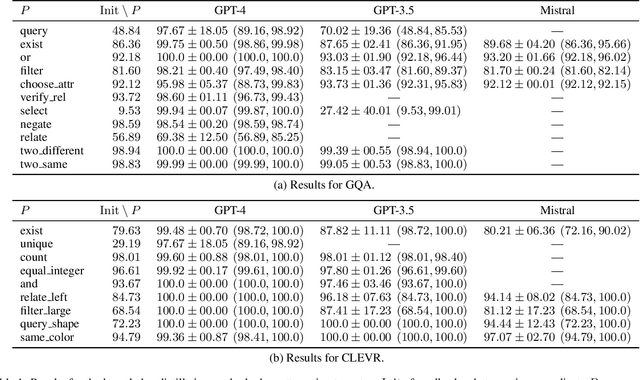
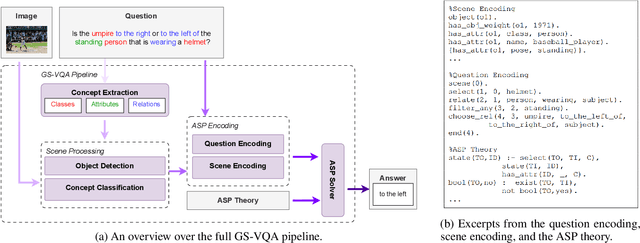

Abstract:Visual Question Answering (VQA) is the task of answering a question about an image and requires processing multimodal input and reasoning to obtain the answer. Modular solutions that use declarative representations within the reasoning component have a clear advantage over end-to-end trained systems regarding interpretability. The downside is that crafting the rules for such a component can be an additional burden on the developer. We address this challenge by presenting an approach for declarative knowledge distillation from Large Language Models (LLMs). Our method is to prompt an LLM to extend an initial theory on VQA reasoning, given as an answer-set program, to meet the requirements of the VQA task. Examples from the VQA dataset are used to guide the LLM, validate the results, and mend rules if they are not correct by using feedback from the ASP solver. We demonstrate that our approach works on the prominent CLEVR and GQA datasets. Our results confirm that distilling knowledge from LLMs is in fact a promising direction besides data-driven rule learning approaches.
Answer-Set Programming for Lexicographical Makespan Optimisation in Parallel Machine Scheduling
Dec 18, 2022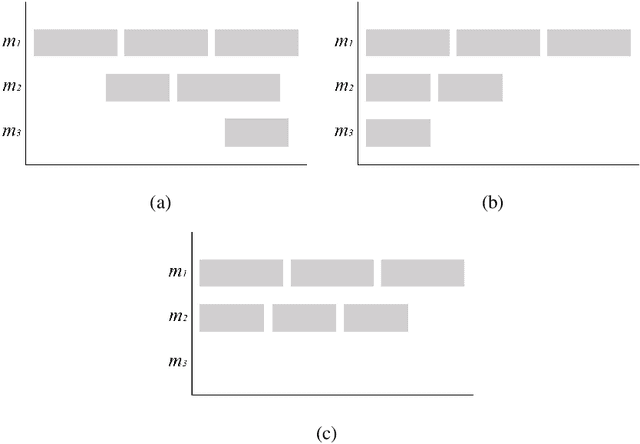

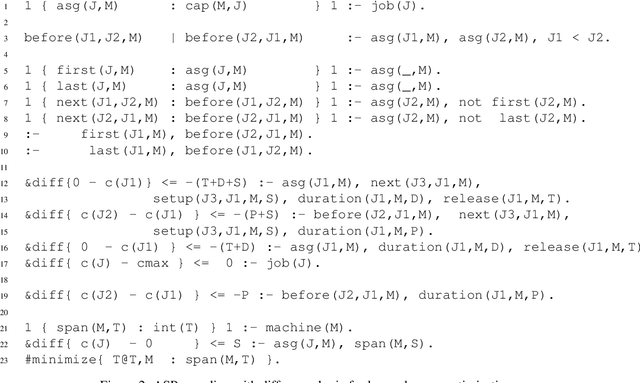

Abstract:We deal with a challenging scheduling problem on parallel machines with sequence-dependent setup times and release dates from a real-world application of semiconductor work-shop production. There, jobs can only be processed by dedicated machines, thus few machines can determine the makespan almost regardless of how jobs are scheduled on the remaining ones. This causes problems when machines fail and jobs need to be rescheduled. Instead of optimising only the makespan, we put the individual machine spans in non-ascending order and lexicographically minimise the resulting tuples. This achieves that all machines complete as early as possible and increases the robustness of the schedule. We study the application of Answer-Set Programming (ASP) to solve this problem. While ASP eases modelling, the combination of timing constraints and the considered objective function challenges current solving technology. The former issue is addressed by using an extension of ASP by difference logic. For the latter, we devise different algorithms that use multi-shot solving. To tackle industrial-sized instances, we study different approximations and heuristics. Our experimental results show that ASP is indeed a promising KRR paradigm for this problem and is competitive with state-of-the-art CP and MIP solvers. Under consideration in Theory and Practice of Logic Programming (TPLP).
A Neuro-Symbolic ASP Pipeline for Visual Question Answering
May 16, 2022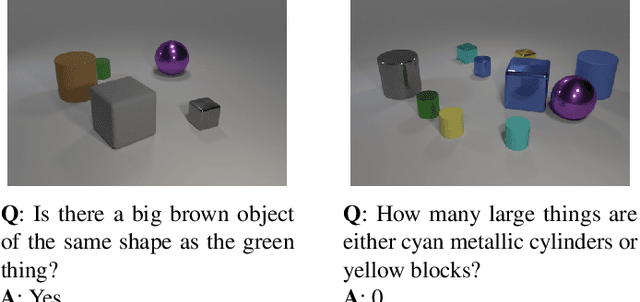

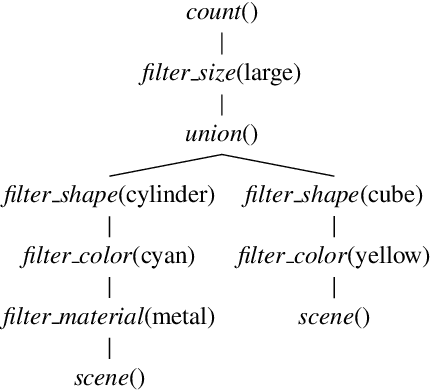
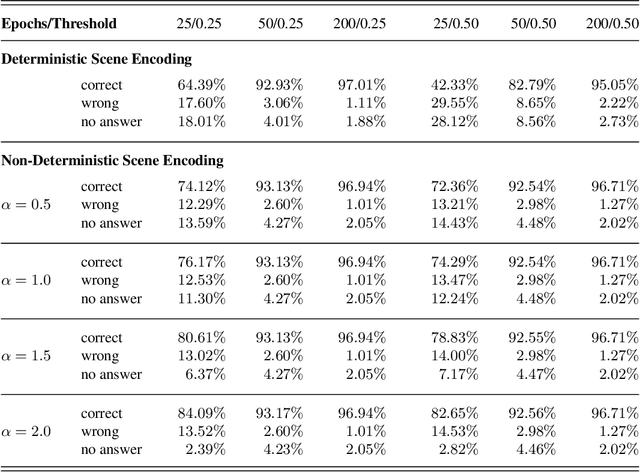
Abstract:We present a neuro-symbolic visual question answering (VQA) pipeline for CLEVR, which is a well-known dataset that consists of pictures showing scenes with objects and questions related to them. Our pipeline covers (i) training neural networks for object classification and bounding-box prediction of the CLEVR scenes, (ii) statistical analysis on the distribution of prediction values of the neural networks to determine a threshold for high-confidence predictions, and (iii) a translation of CLEVR questions and network predictions that pass confidence thresholds into logic programs so that we can compute the answers using an ASP solver. By exploiting choice rules, we consider deterministic and non-deterministic scene encodings. Our experiments show that the non-deterministic scene encoding achieves good results even if the neural networks are trained rather poorly in comparison with the deterministic approach. This is important for building robust VQA systems if network predictions are less-than perfect. Furthermore, we show that restricting non-determinism to reasonable choices allows for more efficient implementations in comparison with related neuro-symbolic approaches without loosing much accuracy. This work is under consideration for acceptance in TPLP.
Stepwise Debugging of Answer-Set Programs
May 18, 2017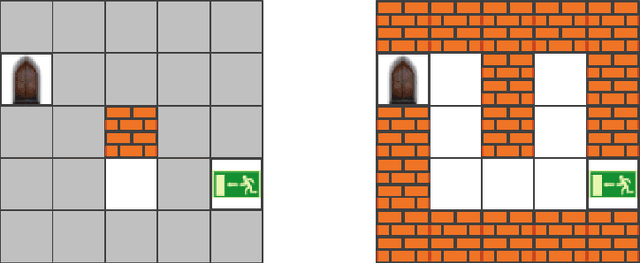
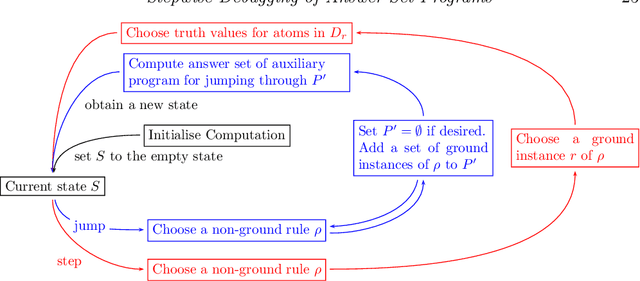
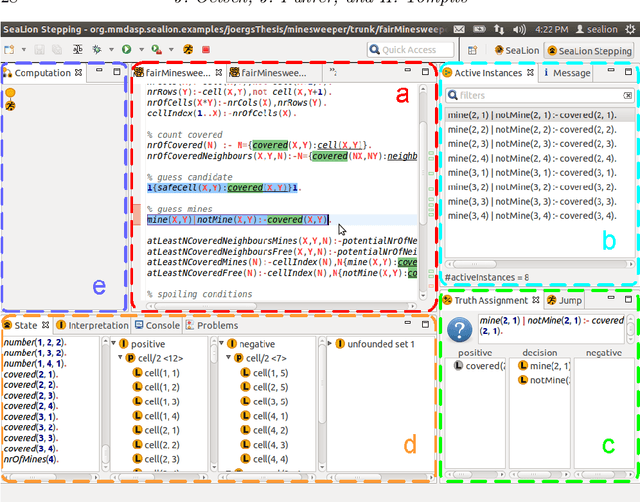
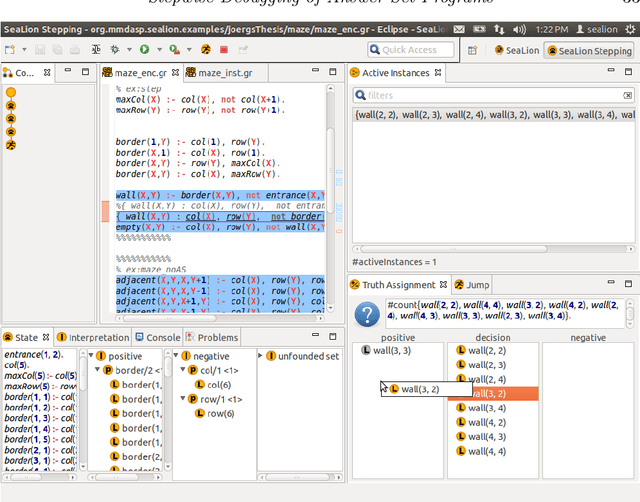
Abstract:We introduce a stepping methodology for answer-set programming (ASP) that allows for debugging answer-set programs and is based on the stepwise application of rules. Similar to debugging in imperative languages, where the behaviour of a program is observed during a step-by-step execution, stepping for ASP allows for observing the effects that rule applications have in the computation of an answer set. While the approach is inspired from debugging in imperative programming, it is conceptually different to stepping in other paradigms due to non-determinism and declarativity that are inherent to ASP. In particular, unlike statements in an imperative program that are executed following a strict control flow, there is no predetermined order in which to consider rules in ASP during a computation. In our approach, the user is free to decide which rule to consider active in the next step following his or her intuition. This way, one can focus on interesting parts of the debugging search space. Bugs are detected during stepping by revealing differences between the actual semantics of the program and the expectations of the user. As a solid formal basis for stepping, we develop a framework of computations for answer-set programs. For fully supporting different solver languages, we build our framework on an abstract ASP language that is sufficiently general to capture different solver languages. To this end, we make use of abstract constraints as an established abstraction for popular language constructs such as aggregates. Stepping has been implemented in SeaLion, an integrated development environment for ASP. We illustrate stepping using an example scenario and discuss the stepping plugin of SeaLion. Moreover, we elaborate on methodological aspects and the embedding of stepping in the ASP development process.
Annotating Answer-Set Programs in LANA?
Oct 08, 2012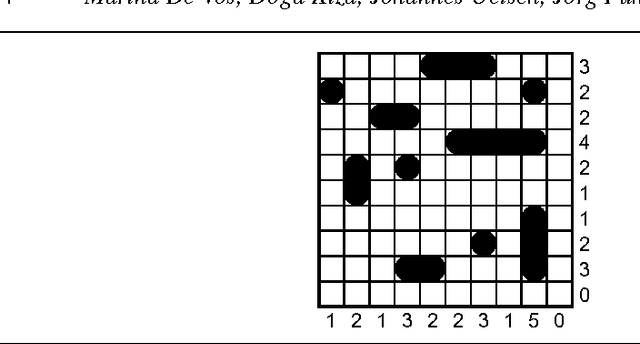
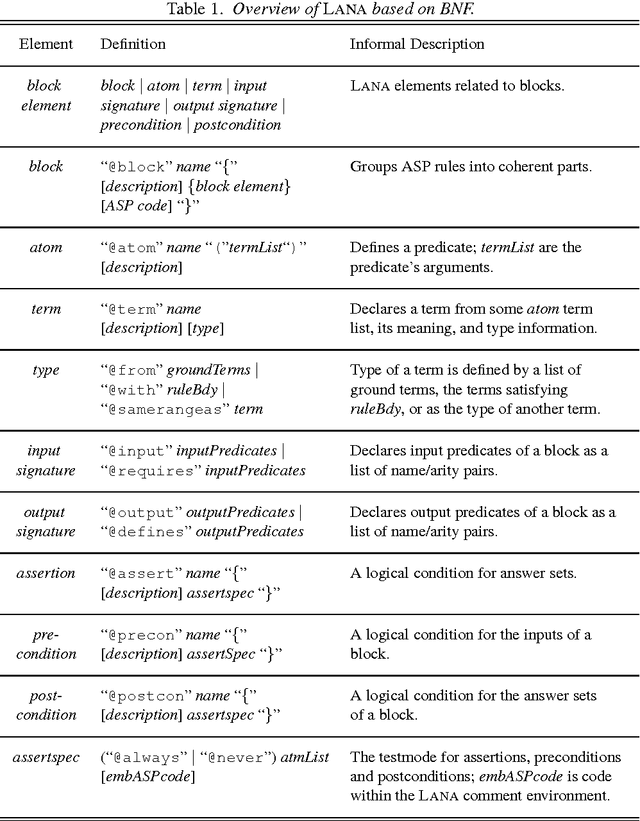
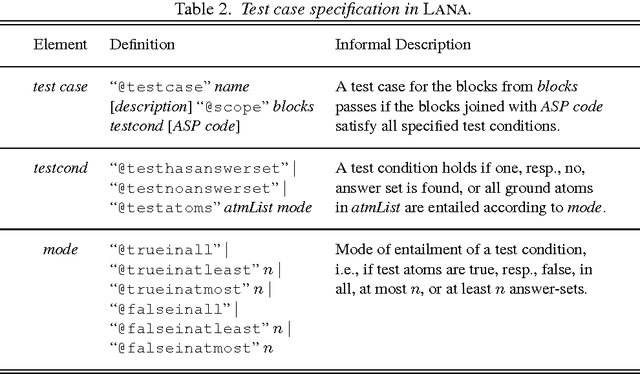
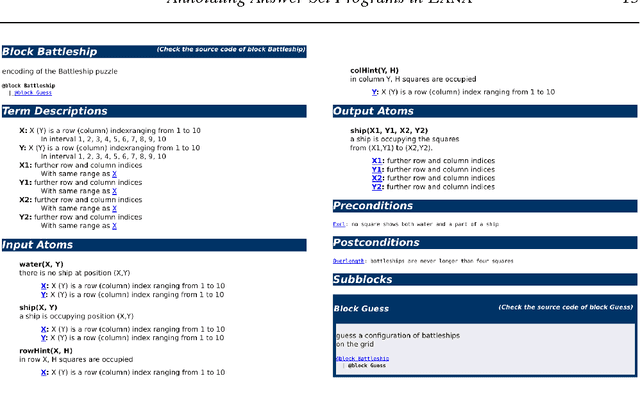
Abstract:While past research in answer-set programming (ASP) mainly focused on theory, ASP solver technology, and applications, the present work situates itself in the context of a quite recent research trend: development support for ASP. In particular, we propose to augment answer-set programs with additional meta-information formulated in a dedicated annotation language, called LANA. This language allows the grouping of rules into coherent blocks and to specify language signatures, types, pre- and postconditions, as well as unit tests for such blocks. While these annotations are invisible to an ASP solver, as they take the form of program comments, they can be interpreted by tools for documentation, testing, and verification purposes, as well as to eliminate sources of common programming errors by realising syntax checking or code completion features. To demonstrate its versatility, we introduce two such tools, viz. (i) ASPDOC, for generating an HTML documentation for a program based on the annotated information, and (ii) ASPUNIT, for running and monitoring unit tests on program blocks. LANA is also exploited in the SeaLion system, an integrated development environment for ASP based on Eclipse. To appear in Theory and Practice of Logic Programming
Extending Object-Oriented Languages by Declarative Specifications of Complex Objects using Answer-Set Programming
Dec 06, 2011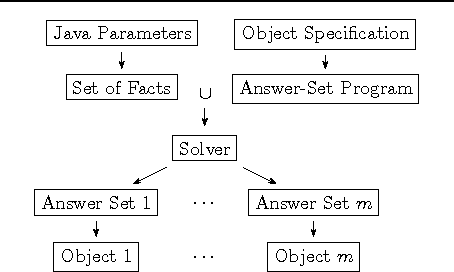
Abstract:Many applications require complexly structured data objects. Developing new or adapting existing algorithmic solutions for creating such objects can be a non-trivial and costly task if the considered objects are subject to different application-specific constraints. Often, however, it is comparatively easy to declaratively describe the required objects. In this paper, we propose to use answer-set programming (ASP)---a well-established declarative programming paradigm from the area of artificial intelligence---for instantiating objects in standard object-oriented programming languages. In particular, we extend Java with declarative specifications from which the required objects can be automatically generated using available ASP solver technology.
Kara: A System for Visualising and Visual Editing of Interpretations for Answer-Set Programs
Oct 11, 2011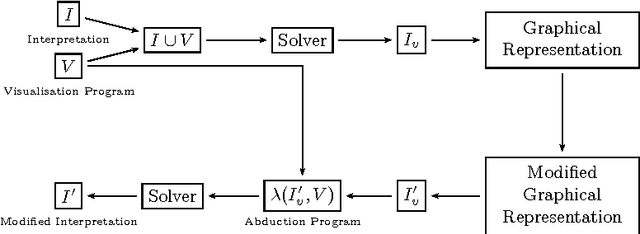
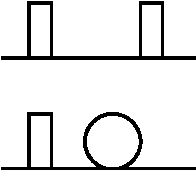

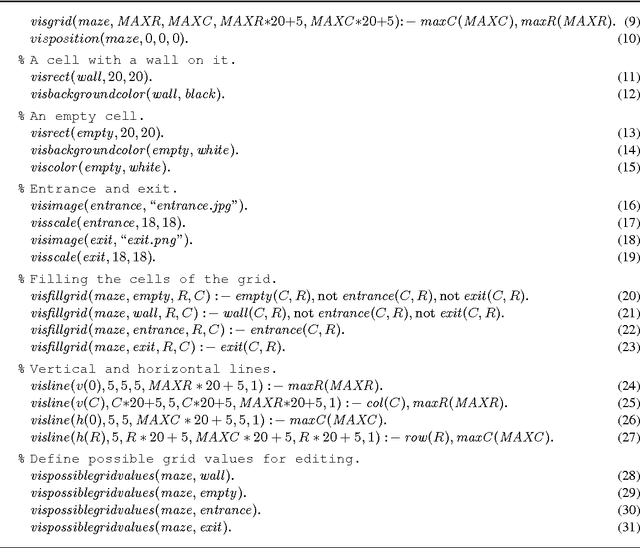
Abstract:In answer-set programming (ASP), the solutions of a problem are encoded in dedicated models, called answer sets, of a logical theory. These answer sets are computed from the program that represents the theory by means of an ASP solver and returned to the user as sets of ground first-order literals. As this type of representation is often cumbersome for the user to interpret, tools like ASPVIZ and IDPDraw were developed that allow for visualising answer sets. The tool Kara, introduced in this paper, follows these approaches, using ASP itself as a language for defining visualisations of interpretations. Unlike existing tools that position graphic primitives according to static coordinates only, Kara allows for more high-level specifications, supporting graph structures, grids, and relative positioning of graphical elements. Moreover, generalising the functionality of previous tools, Kara provides modifiable visualisations such that interpretations can be manipulated by graphically editing their visualisations. This is realised by resorting to abductive reasoning techniques. Kara is part of SeaLion, a forthcoming integrated development environment (IDE) for ASP.
The SeaLion has Landed: An IDE for Answer-Set Programming---Preliminary Report
Oct 11, 2011
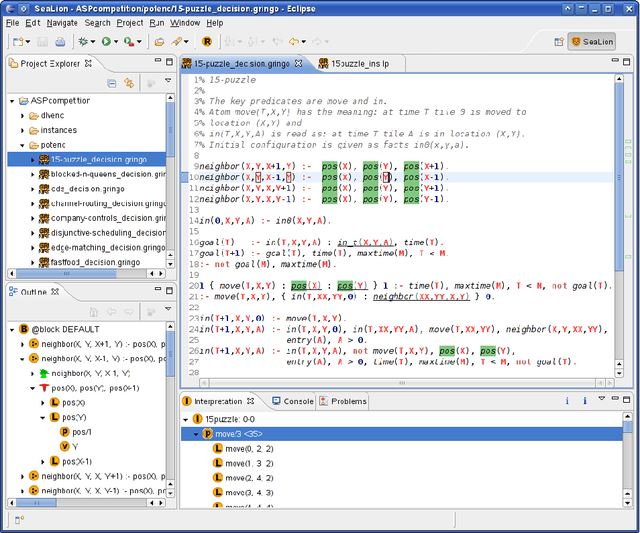
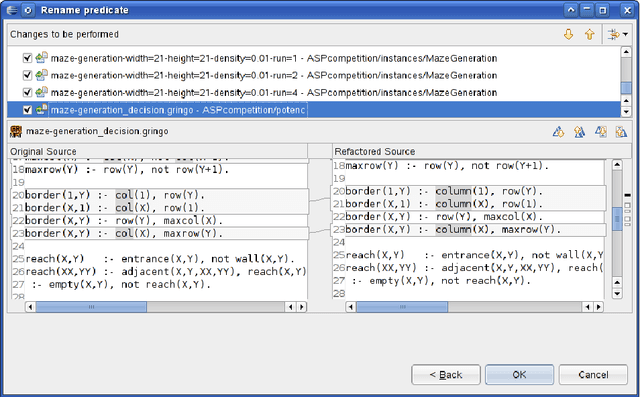
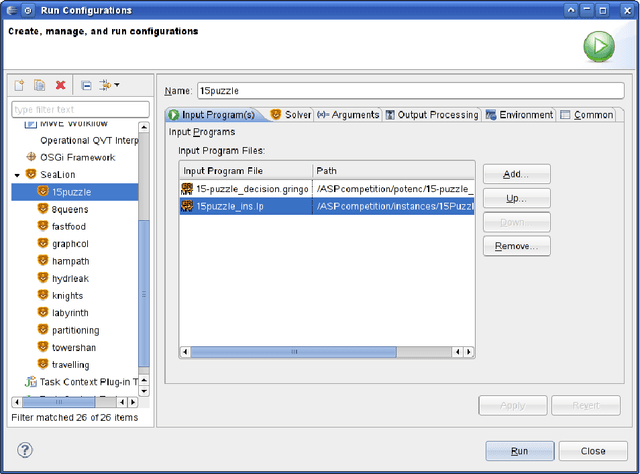
Abstract:We report about the current state and designated features of the tool SeaLion, aimed to serve as an integrated development environment (IDE) for answer-set programming (ASP). A main goal of SeaLion is to provide a user-friendly environment for supporting a developer to write, evaluate, debug, and test answer-set programs. To this end, new support techniques have to be developed that suit the requirements of the answer-set semantics and meet the constraints of practical applicability. In this respect, SeaLion benefits from the research results of a project on methods and methodologies for answer-set program development in whose context SeaLion is realised. Currently, the tool provides source-code editors for the languages of Gringo and DLV that offer syntax highlighting, syntax checking, and a visual program outline. Further implemented features are support for external solvers and visualisation as well as visual editing of answer sets. SeaLion comes as a plugin of the popular Eclipse platform and provides itself interfaces for future extensions of the IDE.
 Add to Chrome
Add to Chrome Add to Firefox
Add to Firefox Add to Edge
Add to Edge